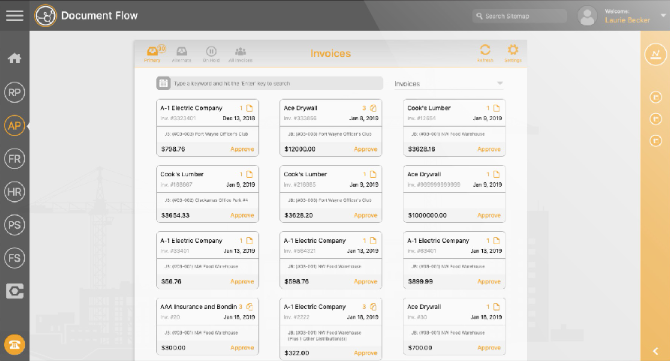Did you know that inefficient submittal management can lead to project delays of up to 20% and cost overruns exceeding 15%?
Construction submittals are the backbone of successful project execution. These critical documents ensure all project components meet specified standards and requirements, serving as a vital communication tool between contractors, architects, and engineers.
This guide will provide you with a complete understanding of construction submittals, including their different types, how they are processed, the common challenges they present, and the best ways to handle them. Whether you're a contractor, architect, or project manager, mastering the submittal process is crucial for your project's success.
By the end of this article, you'll have the knowledge to manage submittals effectively, ensuring quality and compliance in every phase of your construction projects. You'll discover how hh2's project management tools, particularly our Document Flow solution, can streamline your submittal process, saving you time and reducing errors.
Lean construction submittal processes can lead to measurable savings in process and lead times by reducing or eliminating nonvalue activities and improving overall efficiency.
- Deborah F. Garrett, Jim Lee
What Are Construction Submittals?
Construction submittals are critical documents, drawings, and samples that contractors submit to architects and engineers for approval before and during the construction process. They ensure that all materials and products used in the project meet the specifications and requirements set forth in the contract documents.
Key types of submittals include:
Shop Drawings
Detailed drawings prepared by contractors or suppliers, showing how specific portions of the work will be fabricated and installed. These drawings provide crucial information, such as dimensions, materials, and assembly instructions, ensuring that the work aligns with the project's specifications and design intent.
Product Data
Information sheets that provide specifications, manufacturer details, and installation instructions for various materials and products used in the construction. These documents verify the products meet the required standards and performance criteria. Typical product data sheets cover information on everything from HVAC systems to electrical components.
Samples
Physical examples of materials, such as paint, tiles, or carpeting, are submitted for approval to ensure they meet the aesthetic and quality standards required by the project. Approving samples ensures consistency and quality across the project.
Mock-ups
Full-scale models of specific components or assemblies used to evaluate design and materials.
Operations and Maintenance Manuals
Documents providing instructions on the operation and maintenance of installed systems and equipment.
Warranties
Guarantees provided by manufacturers or contractors covering the quality and performance of materials and workmanship.

The Importance of Submittals in Construction
Quality Assurance
Submittals play a vital role in quality assurance by ensuring that all materials and workmanship meet the project's specifications. Through detailed review and approval processes, submittals verify that the products and methods used align with the design intent and performance criteria set forth in the contract documents. This process helps prevent defects and ensures the project's durability and safety.
Communication
Effective communication is crucial in construction projects, and submittals facilitate clear and structured communication between all stakeholders, including contractors, architects, engineers, and clients. Submittals provide a formal means to convey information about materials, products, and methods, ensuring that everyone agrees. This clarity helps to avoid misunderstandings and misinterpretations, leading to a smoother construction process.
Compliance
Construction projects must adhere to various regulatory and contractual requirements. Submittals ensure that all materials and methods comply with these regulations and the specific terms of the contract. By documenting and verifying compliance, submittals help avoid legal issues, fines, and project delays. They provide a record of adherence to standards, which can be critical for inspections and audits.
The Submittal Process
The submittal process typically involves three main stages:
Submission
In this initial stage, contractors are responsible for preparing and submitting the necessary documents, drawings, and samples. These are usually submitted at the beginning of a project or as specified milestones are reached. The timing and specifics of these submissions are outlined in the project contract and specifications.
Review
Once the submittals are received, they undergo a thorough review process. This typically involves architects, engineers, and other relevant stakeholders. The review process includes:
- Initial Check: Ensuring all required documents are included and properly formatted.
- Detailed Review: Examining the details of the submittals to ensure compliance with project specifications and design intent.
- Feedback: Providing comments and requesting revisions if necessary.
This collaborative effort helps catch potential issues early, preventing costly delays and rework.
Approval
After the review process, the submittals are categorized into one of the following outcomes:
- Approved: The submittal meets all requirements and is accepted without any changes.
- Approved with Comments: The submittal is generally acceptable but requires minor revisions or clarifications.
- Rejected: The submittal does not meet the requirements and must be resubmitted with significant changes.

Common Challenges in Submittal Management
Delays
Causes: Delays in the submittal process can be caused by incomplete submissions, prolonged review times, and miscommunication between stakeholders.
Solutions: To mitigate delays, ensure all submittals are complete and accurate before submission, use automated workflow tools for timely reviews, and maintain clear, consistent communication among all parties.
Errors
Common Mistakes: Frequent errors include submitting outdated documents, incorrect formatting, and missing information.
Avoidance: Implementing a robust quality control system can help catch errors before submission. Regular training on submittal requirements and using software tools to check for completeness can also reduce mistakes.
Coordination
Challenges: Ensuring alignment and keeping all stakeholders informed can be difficult, especially on large projects.
Solutions: Effective project management tools that provide real-time updates and centralized communication platforms can ensure everyone is on the same page.
Best Practices for Managing Submittals
Organization
Keeping submittals organized and accessible is crucial for efficient project management. Use a centralized system to store and track all submittals, ensuring they are easily retrievable and up-to-date. Categorize documents by type, date, and status to streamline the review and approval process.
Technology
Leveraging software tools can significantly enhance the submittal process. hh2 offers advanced project management solutions, such as Document Flow, which automate workflows, track document status, and facilitate real-time collaboration. These tools help reduce errors, save time, and ensure compliance.
Communication
Maintaining clear and consistent communication is essential for the success of submittal management. Establish regular check-ins and updates among team members to keep everyone informed of the submittal status and any required actions. Utilize collaborative platforms that allow for instant feedback and documentation sharing, ensuring all stakeholders are aligned and informed throughout the project.
Innovative technology can streamline the construction submittal process, reducing unnecessary costs and improving quality control.
- E. William East, Danielle R. Love
How hh2's Document Flow Streamlines the Submittal Process
hh2's Document Flow solution revolutionizes submittal management through:
Centralized Document Management
Our platform allows for the centralized storage and management of all submittal documents. This ensures that all team members have access to the latest versions, reducing the risk of using outdated information.
Automated Workflows
We provide automated workflows that guide the submittal through the necessary review and approval stages. This automation reduces the time required for manual handling and minimizes the chance of human error.
Real-Time Collaboration
Our tools enable real-time collaboration among team members, allowing for immediate feedback and adjustments. This feature ensures that any issues can be quickly identified and resolved, keeping the project on track.
Tracking and Reporting
Detailed tracking and reporting features help monitor the progress of each submittal, providing visibility of the status and any potential bottlenecks. This transparency helps in proactive management and timely decision-making.
Integration with Other Systems
Our tools integrate seamlessly with other project management and construction software, ensuring that submittals and related documents are synchronized across platforms. This integration further reduces the likelihood of errors and inconsistencies.

Close collaboration between parties in a design-bid-build project leads to faster cycles of review and approval, leading to higher success rates in submittals.
- A. Pestana, T. Alves
Frequently Asked Questions
Q: How long should the submittal review process take?
A: While it varies by project complexity, a typical review should take 7-14 days. Using tools like hh2's Document Flow can significantly reduce this timeframe by automating workflows and facilitating faster communication.
Q: What happens if a submittal is rejected?
A: The contractor must revise and resubmit the document, addressing all noted issues. hh2's system helps track these revisions and ensures nothing falls through the cracks, maintaining a clear audit trail of all changes and approvals.
Q: How can I improve the efficiency of our submittal process?
A: Implementing a digital solution like hh2's Document Flow can streamline your process, reducing errors and saving time through automation and improved collaboration. Additionally, providing clear guidelines to all stakeholders and maintaining consistent communication can significantly enhance efficiency.
Q: Are electronic submittals becoming the industry standard?
A: Yes, electronic submittals are increasingly becoming the norm in the construction industry. They offer numerous advantages including faster processing, easier tracking, and reduced environmental impact. hh2's Document Flow is designed to support this digital transition seamlessly.
Q: How does hh2's Document Flow handle large files like detailed shop drawings?
A: hh2's Document Flow is built to handle large files efficiently. It uses advanced file compression techniques and cloud storage solutions to ensure that even the most detailed shop drawings can be uploaded, shared, and reviewed without performance issues.
Conclusion
Mastering construction submittals is essential for project success. By understanding the process, addressing common challenges, and leveraging advanced tools like hh2's Document Flow, you can significantly improve your project outcomes. Efficient submittal management leads to fewer delays, reduced costs, and higher quality results.
The construction industry is evolving, and digital solutions are at the forefront of this change. hh2's Document Flow is designed to meet the growing needs of modern construction projects, offering a comprehensive solution for submittal management that adapts to your specific requirements.
Ready to revolutionize your submittal management and take your project efficiency to the next level? Explore hh2's Construction Management Solutions and see how our Document Flow can transform your project efficiency. Don't let outdated submittal processes hold your projects back – embrace the future of construction management with hh2.
Further reading
Supercharge Your Back-Office
Eliminate manual data entry and manual errors while simplifying nearly every back-office process with hh2's construction solutions.
Blog Transcript



